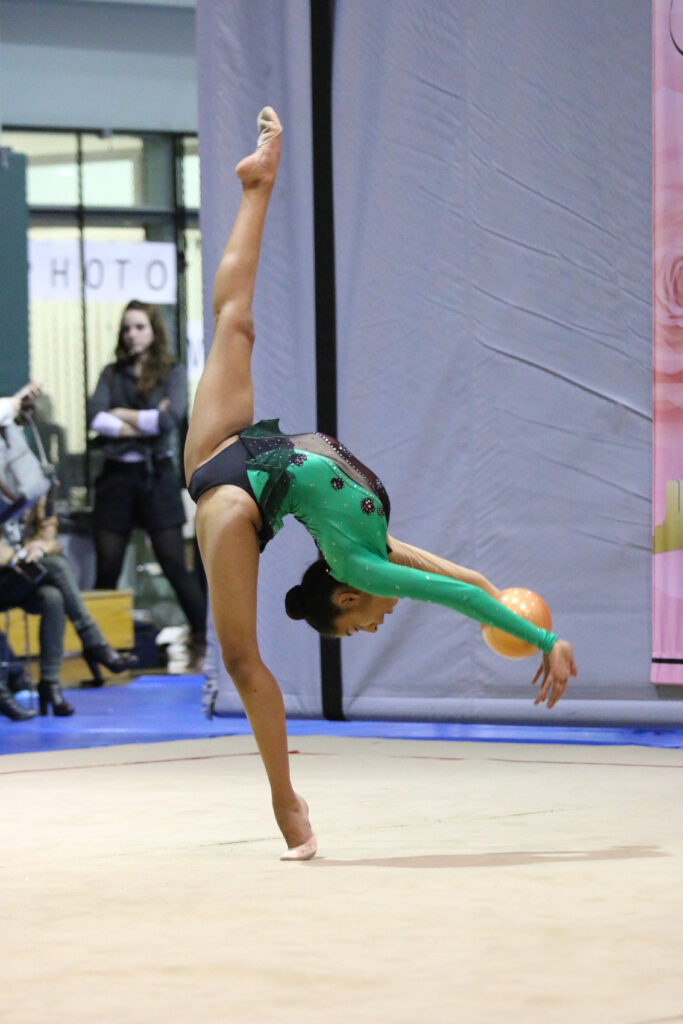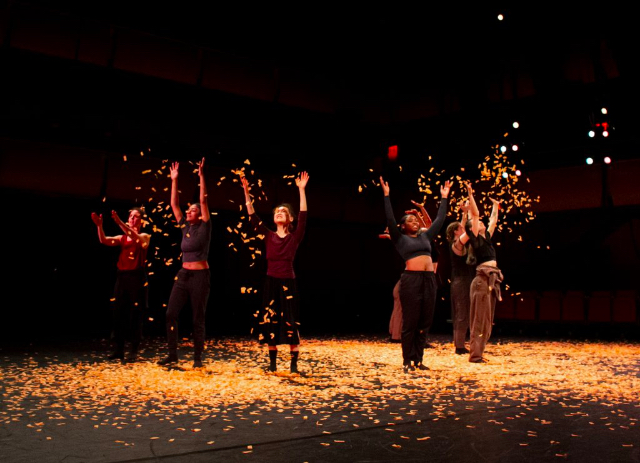Gurmukhi Bevli was a rhythmic gymnast for 11 years. She was a member of the Team USA Youth Elite Squad for three years and has competed both nationally and internationally as a Level 10 gymnast. Gurmukhi retired from the sport in 2017, and is entering her senior year at UCLA, majoring in dance.
Gurmukhi first discovered rhythmic gymnastics in 2006. She was living in India at the time, and that year, the Asian Gymnastics Championships were held in her home city. “I watched [the competition], and I just fell in love with rhythmic. I knew that’s what I wanted to do.”
In 2008, Gurmukhi and her family moved permanently to the U.S. They stumbled across a newspaper advertisement for a rhythmic gym in Anaheim, and that was her introduction into competitive gymnastics. During the nine years that followed, she won multiple state and regional titles, made it to the highest level in the sport, and has traveled to places like Puerto Rico, Russia and India for competition.
From 1st through 8th grade, Gurmukhi was homeschooled, and then attended a public high school. On balancing gymnastics with academics, Gurmukhi says, “It was difficult managing both. I went to a school that was very STEM focused. I retired from gymnastics during my senior year, because I wanted to go to college and had a plan set for higher education. It wasn’t feasible to continue training at the same time. I am grateful for having a great support system while doing gymnastics in high school. I had my food and schedule looked after by other people, which made it a lot easier for me to focus on my job.”

When applying to colleges, Gurmukhi never intended to major in dance. “I was pretty set on a career in STEM. But I saw the dance major listed under the colleges’ offered programs and decided to explore it further. I thought to myself, ‘I have experience in dance, so why not check it out?’ When I auditioned at different colleges and learned more about the dance programs and what they were going to teach us, I became very committed to being a dance major, because I really enjoyed what they were about.”
Gurmukhi’s background made her a unique candidate for university dance programs. “I was trained in classical Indian dance, which I started a little before I began rhythmic. I also did a lot of ballet to supplement my training for rhythmic. I had done other styles here and there, like ballroom and jazz, not professionally, but I had at least been exposed to different genres of dance.”
Gurmukhi was accepted to UCLA’s dance program and began college in 2018. She explains the structure of the major: “UCLA’s dance program is not conservatory focused. Their goal is to build dance scholars, rather than simply physical dancers. So in your first two years, you’ll have dance theory courses, where you’ll learn about things like world dance history and theories of dance. In your second year you’ll move into composition courses, where you’ll learn about choreography and how to analyze dance. To supplement that training you have your movement courses, which are actual physical lab classes that teach you different styles of dance. In the last year of the program, you move into doing independent research.”
Dance and Rhythmic Gymnastics
When asked how her rhythmic gymnastics background tied into dancing, Gurmukhi says, “It was nice to have a rhythmic background in terms of what my body could do. It was interesting because after coming to UCLA, I realized how much the rhythmic community is unaware about dance. We are very performative, and we use dance to express ourselves on the carpet. But in terms of understanding where those dance forms originate from, and what they mean in a societal context, we’re very uninformed.”
Gurmukhi continues, “We culturally appropriate dance forms a lot in the rhythmic community. A lot of it stems from ignorance, and not necessarily a specifically motivated appropriation. I realized that after coming into the dance major, and learning about the implications of appropriating a dance form without providing that community with the credit it deserves. In rhythmic, I would see girls doing routines to Indian music, and you could tell they had not researched anything about Indian dance or its origins, and they would just twirl a ribbon and shake their necks around, and that would be their representation of an Indian routine. That’s extremely exploitative. Obviously I don’t blame anyone in the community for that, it’s just lack of awareness. When you’re creating a routine, it’s partly your job to make sure that you do enough research before you present this work to an outside audience. The biggest thing I’ve taken away [from the dance major] is having accountability in your artmaking practice, as a dancer and choreographer. That’s important because you have to acknowledge that your art is reaching a very wide audience, and you have to think about the implications of them seeing it and how they’re going to contextualize it.”


As for her long-term dance aspirations, Gurmukhi says, “Right now, if I’m being honest, I have no idea what I want to do [after college]. I have a couple different avenues that I’m looking into. I’m interested in understanding how the brain feeds into the perceptions of our creative process. Why is it that the audience finds some aspects of dance so meaningful and powerful, and others kind of fall flat– what’s the psychology behind that? I’m also interested in pursuing dance as a choreographer, but with the aim of education, and maybe hopefully become a professor.”
Interested in the science of dance and creativity, Gurmukhi took several neuroscience courses at UCLA. She has studied extensively about brain functioning and the interplay between neurochemistry, behavior and environment. Applying her knowledge to the oftentimes toxic and abusive culture of competitive gymnastics, Gurmukhi says, “I feel really upset about how much gymnastics culture represses athletes’ emotions and their mental health. I think it’s very damaging, because you’re dealing with a set of people who are in the most vulnerable period of their lives– age 10 to 25. And you’re repressing their mental health issues. In doing so, you’re creating a set of problems that’s going to follow them around for the rest of their lives, and when they want to talk about it, you don’t even give them a safe space to do it. I think that’s a big issue that we have to address. I’m glad that athletes are starting to come forward with their experiences, but I think it’s going to be a slow process to get people with power in these communities to understand how important athletes’ mental health is.”
Gurmukhi has seen and witnessed firsthand the toxicity of gymnastics environments. “When I left my old gym in 2014 and switched, there was a period when I saw how much mental and psychological abuse was present in the sport. You’re a 15 year-old athlete, and yet you’re being addressed as if you’re a fully mature, self-sufficient adult, and I think that’s really problematic. There are other aspects of the environment, like how controlling coaches could be, that were damaging. It’s [the coach’s] job to raise an athlete, it’s not their job to parent them. Leave the emotional and psychological element for the actual parents to deal with. I don’t think it was in the coach’s place to try and raise me as a human being. You don’t get to control who I go out with, who my friends are, what I do outside of the gym. I give a lot of credit to my parents because they were really supportive throughout my career, and they helped me tackle my personal mental health issues. They were very nonjudgmental and supportive, so that was really nice.”
Despite the hardships, Gurmukhi has also taken away many positives from her time as a gymnast. “Gymnastics taught me discipline, for sure. Not just discipline in terms of tasks I need to get done, but in the way I interact with people, and how I set time aside for the things I want to accomplish. My training has helped me a lot because I’ve been in an environment of high achieving, high functioning people before, so it’s helped me fit back into that mold now, as a dance major. Gymnastics also taught me some technical skills, like how to approach any performance setting. I miss training and the structure of going to the gym and seeing my teammates and closest friends on a regular basis. I also miss the atmosphere of friendly competition during the early stages of my career, before things got really stressful.”
Advice for Athletes
When asked what pieces of advice she would offer to young athletes, Gurmukhi says, “Give yourself time to process your emotions. You’re not weak for feeling like you need time to think about things that are happening and changing around you. And go to therapy. Just take advantage of that resource, it will help you figure out what is going on in your life. Ask yourself, ‘Am I okay?’ Not just physically, but mentally as well. It’s important to be able to think for yourself. Every athlete has to retire at some point, and there is a whole world out there. Sport is great and can be your life, but you don’t have to use it to pigeonhole yourself into one identity and feel like you’re a unidimensional person. You have a bunch of things that are awesome about you, and you shouldn’t let one aspect of your life dampen all the others.”


0 Comments